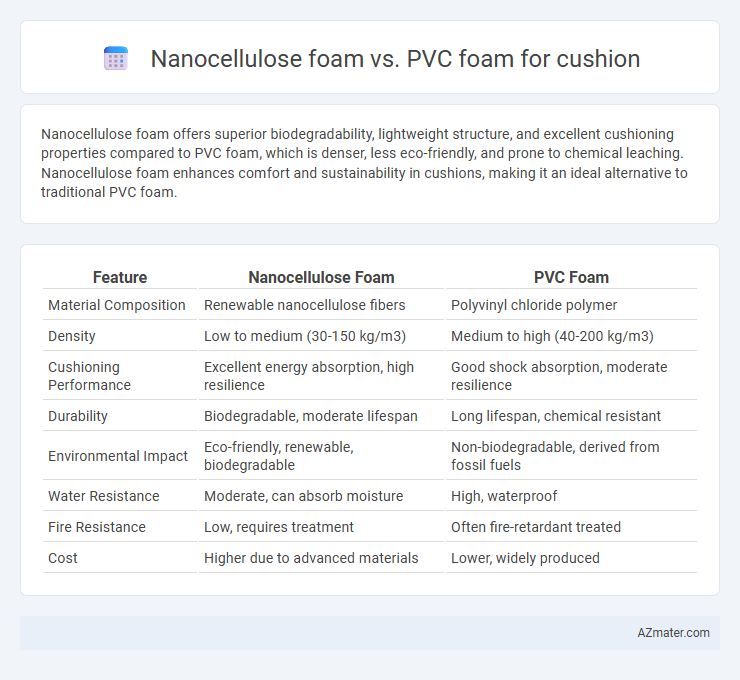Nanocellulose foam offers superior biodegradability, lightweight structure, and excellent cushioning properties compared to PVC foam, which is denser, less eco-friendly, and prone to chemical leaching. Nanocellulose foam enhances comfort and sustainability in cushions, making it an ideal alternative to traditional PVC foam.
Table of Comparison
| Feature | Nanocellulose Foam | PVC Foam |
|---|---|---|
| Material Composition | Renewable nanocellulose fibers | Polyvinyl chloride polymer |
| Density | Low to medium (30-150 kg/m3) | Medium to high (40-200 kg/m3) |
| Cushioning Performance | Excellent energy absorption, high resilience | Good shock absorption, moderate resilience |
| Durability | Biodegradable, moderate lifespan | Long lifespan, chemical resistant |
| Environmental Impact | Eco-friendly, renewable, biodegradable | Non-biodegradable, derived from fossil fuels |
| Water Resistance | Moderate, can absorb moisture | High, waterproof |
| Fire Resistance | Low, requires treatment | Often fire-retardant treated |
| Cost | Higher due to advanced materials | Lower, widely produced |
Introduction to Cushioning Materials
Nanocellulose foam and PVC foam are prominent cushioning materials with distinct properties affecting comfort and sustainability. Nanocellulose foam offers high biodegradability, low density, and excellent mechanical strength, making it ideal for eco-friendly cushioning applications. PVC foam provides durability, water resistance, and cost-effectiveness, widely used in traditional upholstery and industrial cushions.
Overview of Nanocellulose Foam
Nanocellulose foam, derived from cellulose nanofibers, offers a lightweight, biodegradable, and highly porous structure ideal for cushion applications. Its superior mechanical strength, high water retention capacity, and excellent thermal insulation make it a sustainable alternative to traditional PVC foam. Nanocellulose foam also exhibits enhanced breathability and reduced environmental impact compared to the petrochemical-based PVC foam commonly used in cushioning.
Key Properties of PVC Foam
PVC foam features excellent durability, high water resistance, and strong chemical stability, making it a preferred material for cushions used in marine and outdoor applications. Its closed-cell structure provides superior cushioning and impact absorption compared to nanocellulose foam, which is more biodegradable but less resistant to moisture. PVC foam also offers better fire retardancy and ease of fabrication, enhancing its performance in demanding environments.
Sustainability and Environmental Impact
Nanocellulose foam offers a sustainable alternative to PVC foam by being biodegradable and derived from renewable plant sources, reducing reliance on fossil fuels. Unlike PVC foam, which releases harmful dioxins and other toxic chemicals during production and disposal, nanocellulose foam decomposes naturally without leaving persistent pollutants. The lightweight nature of nanocellulose foam also lowers transportation emissions, further minimizing its environmental impact compared to traditional PVC foam cushions.
Comfort and Performance Comparison
Nanocellulose foam offers superior breathability and moisture-wicking properties compared to PVC foam, enhancing overall comfort during extended use. Its higher resilience and compressive strength provide better support and durability, maintaining cushioning performance under repeated stress. PVC foam, although cost-effective and lightweight, tends to retain heat and degrade faster, which can reduce long-term comfort and performance in cushion applications.
Durability and Longevity
Nanocellulose foam exhibits superior durability and longevity compared to PVC foam due to its high tensile strength and resistance to wear and tear in cushioning applications. Its biodegradable and hydrophobic properties contribute to maintaining structural integrity over extended periods, unlike PVC foam which may degrade and lose elasticity under prolonged stress. Enhanced moisture resistance and mechanical reinforcement in nanocellulose foam ensure sustained cushioning performance and extended product lifespan in various environmental conditions.
Cost Analysis: Nanocellulose vs PVC Foam
Nanocellulose foam offers a sustainable and biodegradable alternative to traditional PVC foam, but currently presents higher production costs due to raw material processing and limited large-scale manufacturing. PVC foam remains cost-effective with established supply chains and mass production techniques, making it the preferred choice for budget-sensitive cushion applications. However, ongoing advancements in nanocellulose extraction and foam fabrication are expected to reduce costs, potentially closing the price gap with PVC foam in the near future.
Applications and Market Trends in Cushions
Nanocellulose foam offers superior biodegradability and lightweight properties compared to PVC foam, making it increasingly favored in eco-friendly cushion applications such as automotive seating and furniture. The growing demand for sustainable materials drives market trends toward nanocellulose foam, which provides enhanced breathability and cushioning comfort. PVC foam remains popular for its durability and cost-effectiveness but faces declining preference due to environmental concerns and stringent regulations promoting green alternatives in cushion manufacturing.
Health and Safety Considerations
Nanocellulose foam offers superior health and safety benefits compared to PVC foam, as it is biodegradable, non-toxic, and free from harmful chemicals like phthalates and chlorine commonly found in PVC. Nanocellulose foam exhibits excellent breathability and hypoallergenic properties, reducing risks of respiratory issues and skin irritations often associated with PVC foam cushions. The combustion of nanocellulose foam produces less toxic fumes than PVC, enhancing fire safety for cushion applications in homes and healthcare environments.
Conclusion: Choosing the Right Foam for Cushions
Nanocellulose foam offers superior sustainability, biodegradability, and breathability compared to PVC foam, which is known for its durability and cost-effectiveness but poses environmental concerns due to its non-biodegradable nature. For eco-conscious consumers prioritizing comfort and environmental impact, nanocellulose foam is the optimal choice, providing excellent cushioning performance with reduced ecological footprint. Those requiring budget-friendly, long-lasting cushions for heavy use might prefer PVC foam despite its environmental drawbacks.

Infographic: Nanocellulose foam vs PVC foam for Cushion
 azmater.com
azmater.com